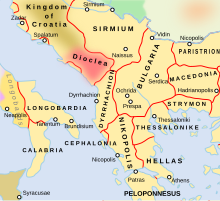Dyrrhachion (Byzantine theme)
The theme of Dyrrhachion ( Greek θέμα Δυρραχίου Théma Dyrrachíou ) was a Byzantine theme in what is now Albania , which stretched along the Adriatic coast . It was established in the early 9th century and named after its capital, Durrës ( Dyrrhachion in Middle Greek ).
history
The exact year the theme was set up is unknown; a strategos of Dyrrhachion is noted in the Taktikon Uspensky from 842, but several seals of strategoi from earlier times have been preserved. It is possible that it originated at the same time as the theme of Peloponnese and the theme of Kephallenia . During the Byzantine-Bulgarian Wars in the 10th and 11th centuries, the city seems to have been independent or under Bulgarian rule at times . From the middle of the 11th century, its governor bore the title Doux or Katepano . In 1040/1041 the troops on the topic rebelled under their leader Tihomir and joined Peter Deljan .
In the late 11th and 12th centuries, Dyrrhachion was of great importance to the Byzantine Empire. The city was the "key to Albania" and the gateway for invasions from Italy. The Doux of Dyrrhachion was raised to the most important rank of all Balkan provinces of the empire. Two governors of Dyrrachion ( Nikephoros Bryennios the Elder and Nikephoros Basilakes ) tried to seize power from here. The region also played an important role in the Byzantine-Norman Wars: it was occupied by the Normans between 1081 and 1084. After the reconquest of the region, Alexios I. Komnenos entrusted the subject to one of his closest relatives. Nevertheless, the local city leaders ( Archons ) retained a relative independence, it was they who surrendered the city to the Venetians in 1205 after the sack of Constantinople .
List of famous strategists
- Leo Rhabdouchos , 917
- Niketas Pegonites , until 1018
- Eustathios Daphnomeles , 1018-1029
- Basil's Synadenos, ca.1040
- Michael Maurex , late 1060s / early 1070s
- Nikephoros Bryennios the Elder , ca.1075
- Nikephorus Basilakes , ca.1078
- Georgios Palaiologos , 1081
- Johannes Doukas , 1085-1092
- Johannes Komnenos , 1092–1105
- Alexios Komnenos, 1105 - after 1108
- Alexios Kontostephanos, second quarter of the 12th century
- Alexios Doukas , mid-12th century
literature
- Michael Angold: The Byzantine Empire, 1025-1204: A Political History . Longman, New York / London 1997, ISBN 0-582-29468-1 ( books.google.de ).
- Alexander Kazhdan: The Oxford Dictionary of Byzantium . Ed .: Aleksandr P. Kazhdan, Alice-Mary Maffry Talbot, Anthony Cutler, Timothy E. Gregory, Nancy Patterson Ševčenko. tape 2 : Esot – Nika. . Oxford University Press, New York / Oxford 1991, ISBN 0-19-504652-8 ( library.upenn.edu - search function).
- John W. Nesbitt, Nicolas Oikonomides: Catalog of Byzantine Seals at Dumbarton Oaks and in the Fogg Museum of Art . tape 1 : Italy, North of the Balkans, North of the Black Sea. . Dumbarton Oaks Research Library and Collection, Washington 1991, ISBN 0-88402-194-7 ( books.google.de ).
- A. Pertusi: Constantino Porfirogenito: De Thematibus . Biblioteca Apostolica Vaticana, Rome 1952.
- Paul Stephenson: Byzantium's Balkan Frontier: A Political Study of the Northern Balkans, 900–1204 . Cambridge University Press, Cambridge, United Kingdom 2000, ISBN 0-521-77017-3 ( smerdaleos.files.wordpress.com [PDF]).
Individual evidence
- ^ A b John W. Nesbitt, Nicolas Oikonomides: Catalog of Byzantine Seals at Dumbarton Oaks and in the Fogg Museum of Art. 1991, p. 40.
- ↑ a b Alexander Kazhdan, et al .: The Oxford Dictionary of Byzantium. 1991, p. 668.
- ↑ A. Pertusi: Constantino Porfirogenito: De Thematibus. 1952, p. 177.
- ↑ Paul Stephenson: Byzantium's Balkan Frontier: A Political Study of the Northern Balkans, 900-1204. 2000, p. 130.
- ↑ Michael Angold: The Byzantine Empire, 1025-1204: A Political History. 1997, pp. 129 ff., 152; Stephenson: Byzantium's Balkan Frontier: A Political Study of the Northern Balkans, 900–1204. 2000, pp. 151-152, 159-160.
- ↑ Paul Stephenson: Byzantium's Balkan Frontier: A Political Study of the Northern Balkans, 900-1204. 2000, p. 184.
